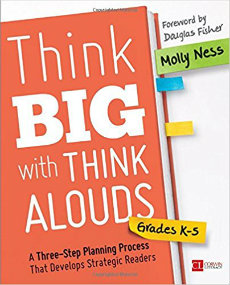Use Think Alouds to Foster Strategic Readers
Think Big with Think Alouds: A Three-Step Planning Process That Develops Strategic Readers
By Molly Ness
(Corwin Literacy, 2018 – Learn more)

Amazing! Brilliant! Molly Ness’s Think Big with Think Alouds: A Three-Step Planning Process That Develops Strategic Readers should be on the bookshelves of all elementary school classrooms and in teachers’ professional libraries.
I felt a kinship with Ness as I read the first chapter. She tells the story of how a comment by Doug Fisher made a profound impact on her teaching. He said, “We all know that think alouds are highly effective, yet teachers don’t do them or can’t do them.” This led to her research study that focused on how to improve a teacher’s ability to effectively apply think alouds in K-5 classrooms.
Following teachers as they develop think alouds

The study consisted of a research team of early-career teachers reading books and journals, writing lesson plans, modeling think alouds, and watching and analyzing videos of teachers “thinking aloud.” The conclusion was that “it was the careful planning of think alouds that mattered most.” (p.2).
This quote resonated with me. We don’t walk into a classroom each day and just start teaching whatever we feel like at that moment. We have a curriculum that is followed and lessons that are well thought out and implemented. We assess what we have taught and whether our students understand the material. Think alouds need to be considered the same way. Think alouds are not a “spur of the moment process,” but a deliberate close reading of a piece of writing before it is shared with the class.
Pinning down the think aloud
Think alouds are sometimes referred to as eavesdropping on a person’s thinking. The purpose of the think aloud is to model/teach students how skilled readers monitor their comprehension and construct meaning from the text. Simply put, think alouds are (p.8):
- Purposeful
- A powerful metacognitive tool
- Build students’ independent abilities to comprehend text
- An essential step in learning
- Apply to all classroom contexts and content
Many things stand out in this book. First is the author’s honesty and candor. Ness tells stories about successes and failures, questions she had, and how she found the answers. As you read the book, you feel as if you are on the learning journey with her. In fact, one entire chapter is about the research process that led up to the publication of the book. You know she has “been there, done that”!
What is also extraordinary is the resources that are available in the book and online. Ness offers 95 pages of resources including sample texts that have already been annotated for you! This book has pages of examples and appendices of scripts that teachers can refer to as best practice material.
Trial Runs with plenty of support
At the end of each chapter, Ness presents a short “Trial Run” that summarizes the chapter and includes reflective questions for the reader. There is so much information in each chapter that you need to take a breath, review what you have read, and think about how you can apply the strategies and information she provides. That’s why the Trial Run is there.
Life is full of “I wishes,” and while reading this book, I had one big “I wish.” I wish it had been written when I first started to use read alouds in my classroom. My first attempts resembled a fizzy drink when you shake it and take your thumb off. I was reading and thinking aloud to my students, but instead of modeling I was gushing, without enough control of the process.
Ness’s three-point strategy
Ness paves the way for a smooth experience by using her three-point strategy.
1. Identify Juicy Stopping Points: During your first reading, examine the text to locate comprehension strategies such as inference or identifying the author’s purpose. (Spoiler alert! You probably will find more than just a few in your first reading.)
2. Determine Where and When to Think Aloud: During your second reading, narrow it down to the strategies you want to focus on in the text. Think about what your objective is for choosing the text. You should have about ONE handful, NOT TWO.
3. Write Scripts on Sticky Notes: During your third reading, plan what you are going to say as you are reading. Script it. Use first person as you practice the strategy. Students need to see purposeful, deliberate, metacognitive thinking.
Undoubtedly, it will seem time consuming in the beginning. Ness doesn’t hide from this fact, but she also says, “As with any skill, I got faster at it as I got into the groove of it…built my confidence and skill in delivering the think aloud.” (p. 79) Once you do this with her mentor text, you are set for life!
An ideal PD book club choice
This is also where collaboration comes in. This book is ideal for a professional development book club. Read the book, talk about the “Trial Run” section after each chapter, and practice writing scripts together.
My advice: Get in the groove. Molly Ness’s book is a resources for all educators—teachers, consultants, curriculum administrators, professors of education. Teachers will gain new insight into their teaching practices, become more fluent when thinking aloud in the classroom, and help students monitor their thinking and comprehension while reading.
Linda Biondi retired last year as a fourth grade teacher at Sharon Elementary School in Robbinsville, NJ where she was a long-time Morning Meeting practitioner. She is the recipient of several educational grants, a Teacher Consultant with the National Writing Project, and was a participant on the NJ Department of Education Teacher Advisory Panel. In 2018 she began working with pre-service teachers.



































Good review. Think-Alouds sound easier than they are.